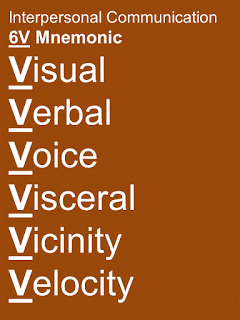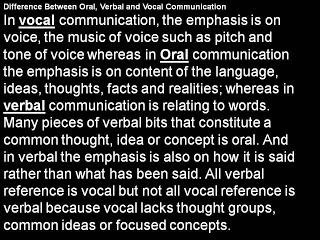Life Skills > Interpersonal Intelligence >

List of Interpersonal Communication Skills
with Examples
Subconscious and Conscious Influence
Subconscious influence is influencing people without they knowing that you are influencing them. And, Conscious influence is they are aware that you are trying to influence them. You can do that by convincing them through bargaining, persuading, or negotiating. However, you have to get into their strong beliefs, opinions and actions that are prevailing from their birth. In order to be successful, you must first believe in yourself, your thoughts and your actions. Second, you communicate it through interactions and actions.Verbal Communication Barriers
There are several verbal communication barriers such as mother tongue influence, verbal fillers, negative or opinion words and statements. One must avoid them or scarcely use them has it can sometimes hinder in building human relationships. Mother tongue influence, commonly known as MTI, is non-standard pronunciation of English words and literal translation of native mother tongue into English. Verbal speech fillers are those unintended utterances such as um, err, uhn, or unnecessary words such as you know, kind of, to name a few. Negative words sometimes hinders human communication and relationships. It includes taboo words, stereotypes, demeaning and discriminating words.
Difference Between Oral, Verbal and Vocal Communication
In vocal communication, the emphasis is on voice, the music of voice such as pitch and tone of voice whereas in Oral communication the emphasis is on content of the language, ideas, thoughts, facts and realities; whereas in verbal communication is relating to words. Many pieces of verbal bits that constitute a common thought, idea or concept is oral. And in verbal the emphasis is also on how it is said rather than what has been said. All verbal reference is vocal but not all vocal reference is verbal because vocal lacks thought groups, common ideas or focused concepts.
Oral Communication Examples:-
Oral means spoken rather than written. For example, she had an oral agreement. The teacherannounced that German oral test will be tomorrow and written test by next week. In oral, the focus will be on the content rather than, unlike verbal, how it is said.
Vocal Communication Examples
It includes some of the key voice elements such as pitch, tone, volume, rate of speech, rhythm, placement of voice, voice contrast, voice clarity, voice stress and distress, intonation, modulation and inflection of voice.Verbal Communication Examples
The words, style of language and figure of speech, mother tongue influence, verbal fillers, positive and negative statements, euphemisms, connotation and denotation, accent, pronunciation, dialect, diction, articulation, sexist language, rapport building phrases, transition phrases, opinion statements, cliché phrases and statements and other language functions such as queries, gratitude, excuses, request, agreement, suggestions and possibilities constitutes verbal communication.Two vital intentions behind any human-human interaction is to either persuasion or empathy. We convince others by our thoughts, ideas and beliefs or we get convinced of other’s opinions, ideas and beliefs. In order to succeed in these two intentions, we need four vital abilities that include intrapersonal, interpersonal, verbal and non-verbal communication skills. Knowing the difference between the synonyms for the word, “verbal” will enhance our knowledge.
Non Verbal Communication
Besides verbal communication, humans also have the ability to express and respond without uttering a word. It is called non-verbal communication skills. It includes, body language, voice, and listening. Being aware of Non verbal communication barriers is one of the essential interpersonal skills to build interesting human relationships for the variety of life roles that we play, from a son, brother, husband to a citizen and professional.Additionally, Spatial (Proxemics), Movement (Kinesics), Time (Chronemics) and Touch (Haptics) are few vital elements of non verbal communication skills Effective verbal and non verbal communication is vital to build interesting human relationships, to influence and persuade people or to deliver an effective presentation. Use of appropriate words, tone or emotion of your voice and effective interpersonal communication will have balance between silence, questions, information and listening.
Body Language
We either respond or react through our body language. For example, you greet your friend saying, "Hello, how are you?" and the person says nothing, then you react to it by changing your facial expressions and will be wondering why the person did not reciprocate. On the other hand, your friend greets you saying, Hello, how are you?" and you respond saying, "Thanks, I'm doing good". The perceptions of responding and reacting depends on people's intrapersonal and interpersonal attitudes and skills.Other body language includes our Posture, I (eye contact), Gestures, and Facial Expressions and the dress that we wear.Voice
Language is one of the vital elements of interaction skills. Besides good Verbal communication skills, one must also have clear and crisp oral/vocal communication skills. It is application of musical skills of your voice. It is also called the prosody of speech or language.Dress
Dress plays a vital role as non-verbal communication. In fact, you can express yourself through the dress that you wear. Wearing appropriate dress is an art. First, you should know the occasion so that you can understand the theme. For example, for a professional interview you must ensure that you wear formal dress whereas for a vacation or party you would wear t-shirts and jeans. Though there are no rules, the dress that you wear can create visual mood and bring certain emotions. Above all, your comfort is as important as consideration for others. The phrase, "Good Dress Code" is subjective. So remember two rules: 1) Are you comfortable wearing this dress? 2) Do you think others will comfortable looking at your dress?An interactive communication either to persuade or empathize happen verbally or non-verbally.
Enhancing your verbal communication skills will help to build interesting human-human Profitable benefits, Authoritative words, Statistics, Testimonials, Emotional appeal. Whether you are giving a speech or trying to resolve a conflict, verbal communication that include short yet effective words, statements that are specific, grammatically standard, with persuading facts, use of rhetorical devices and figure of speech can make any verbal communication rich and strong. A set of interpersonal communication skills include verbal, non-verbal, presentation and written communication skills.
